Related Research Articles
An oratorio is a large musical composition for orchestra, choir, and soloists. Like most operas, an oratorio includes the use of a choir, soloists, an instrumental ensemble, various distinguishable characters, and arias. However, opera is musical theatre, while oratorio is strictly a concert piece – though oratorios are sometimes staged as operas, and operas are sometimes presented in concert form. In an oratorio, the choir often plays a central role, and there is generally little or no interaction between the characters, and no props or elaborate costumes. A particularly important difference is in the typical subject matter of the text. Opera tends to deal with history and mythology, including age-old devices of romance, deception, and murder, whereas the plot of an oratorio often deals with sacred topics, making it appropriate for performance in the church. Catholic composers looked to the lives of saints and histories from the Bible while Protestant composers only to Biblical topics. Oratorios became extremely popular in early 17th-century Italy partly because of the success of opera and the Catholic Church's prohibition of spectacles during Lent. Oratorios became the main choice of music during that period for opera audiences.

Christ lag in Todes Banden, BWV 4, is a cantata for Easter by German composer Johann Sebastian Bach, one of his earliest church cantatas. It is agreed to be an early work partly for stylistic reasons and partly because there is evidence that it was probably written for a performance in 1707. Bach went on to complete many other works in the same genre, contributing complete cantata cycles for all occasions of the liturgical year. John Eliot Gardiner described it as Bach's "first-known attempt at painting narrative in music".

Undine Eliza Anna Smith Moore, the "Dean of Black Women Composers", was an American composer and professor of music in the twentieth century. Moore was originally trained as a classical pianist, but developed a compositional output of mostly vocal music—her preferred genre. Much of her work was inspired by black spirituals and folk music. Undine Smith Moore was a renowned teacher, and once stated that she experienced "teaching itself as an art". Towards the end of her life, she received many awards for her accomplishments as a music educator.
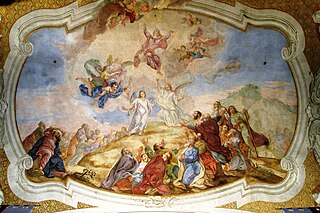
Lobet Gott in seinen Reichen, BWV 11, known as the Ascension Oratorio, is an oratorio by Johann Sebastian Bach, marked by him as Oratorium In Festo Ascensionis Xsti, composed for the service for Ascension and probably first performed on 15 May 1738.
Johann Sebastian Bach composed the church cantata Wär Gott nicht mit uns diese Zeit, BWV 14, in Leipzig in 1735 for the fourth Sunday after Epiphany and first performed it on 30 January 1735, a few weeks after his Christmas Oratorio. The cantata, in Bach's chorale cantata format, is based on Martin Luther's hymn "Wär Gott nicht mit uns diese Zeit". Its text paraphrases Psalm 124, focussing on the thought that the believers' life depends on God's help and is lost without it.
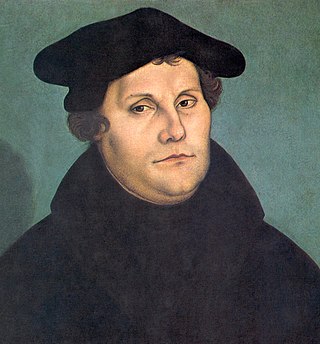
Gelobet seist du, Jesu Christ, BWV 91, is a church cantata by Johann Sebastian Bach. He wrote the Christmas cantata in Leipzig in 1724 for Christmas Day and first performed it on 25 December 1724. The chorale cantata is based on the hymn "Gelobet seist du, Jesu Christ" (1524) by Martin Luther.

Der Tod Jesu is an oratorio libretto by Karl Wilhelm Ramler. In its setting by Carl Heinrich Graun in 1755, it was the most often performed Passion of the 18th century in Germany.

Messiah, the English-language oratorio composed by George Frideric Handel in 1741, is structured in three parts. This listing covers Part II in a table and comments on individual movements, reflecting the relation of the musical setting to the text. Part I begins with the prophecy of the Messiah and his birth, shows the annunciation to the shepherds and reflects the Messiah's deeds on earth. Part II covers the Passion in nine movements including the oratorio's longest movement, an air for alto He was despised, then mentions death, resurrection, ascension, and reflects the spreading of the Gospel and its rejection. The part is concluded by a scene called "God's Triumph" that culminates in the Hallelujah chorus. Part III of the oratorio concentrates on Paul's teaching of the resurrection of the dead and Christ's glorification in heaven.

Messiah, the English-language oratorio composed by George Frideric Handel in 1741, is structured in three parts. This listing covers Part III in a table and comments on individual movements, reflecting the relation of the musical setting to the text. Part I begins with the prophecy of the Messiah and his birth, shows the annunciation to the shepherds as a scene from the Gospel of Luke, and reflects the Messiah's deeds on Earth. Part II covers the Passion, death, resurrection, ascension, and the later spreading of the Gospel. Part III concentrates on Paul's teaching of the resurrection of the dead and Christ's glorification in heaven.
Donald Young Sur was a Korean American composer and musicologist. Although he is best known for his large-scale oratorio, Slavery Documents, most of his works were composed for small chamber ensembles. Sur was born in Honolulu and moved with his family to Los Angeles after World War II. He studied at the University of California and Princeton before spending four years in Korea researching ancient Korean court music. After receiving his doctorate from Harvard in 1972, he settled in Boston, Massachusetts, where many of his works were premiered and where he taught at several local universities, including Harvard, MIT, and Tufts.
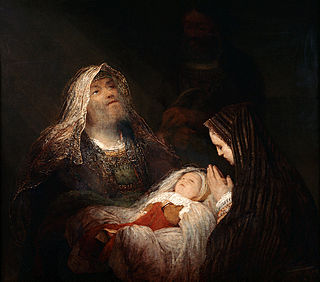
Johann Sebastian Bach composed the cantata Mit Fried und Freud ich fahr dahin, BWV 125, for use in a Lutheran service. He composed this chorale cantata in Leipzig in 1725 for the feast for the Purification of Mary, which is celebrated on 2 February and is also known as Candlemas. The cantata is based on Martin Luther's 1524 hymn "Mit Fried und Freud ich fahr dahin" and forms part of Bach's chorale cantata cycle, written to provide Sundays and feast days of the liturgical year with cantatas based on a related Lutheran hymn.
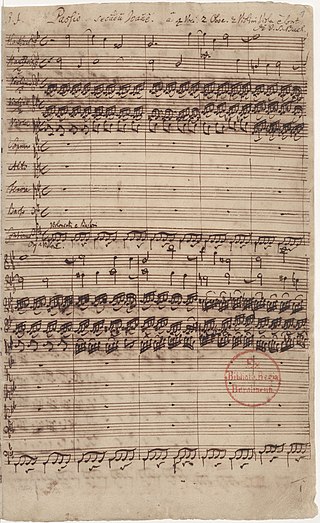
The structure of the St John Passion, BWV 245, a sacred oratorio by Johann Sebastian Bach first performed in Leipzig on Good Friday 1724, is "carefully designed with a great deal of musico-theological intent". Some main aspects of the structure are shown in tables below.
The history of the 1954 to 1968 American civil rights movement has been depicted and documented in film, song, theater, television, and the visual arts. These presentations add to and maintain cultural awareness and understanding of the goals, tactics, and accomplishments of the people who organized and participated in this nonviolent movement.
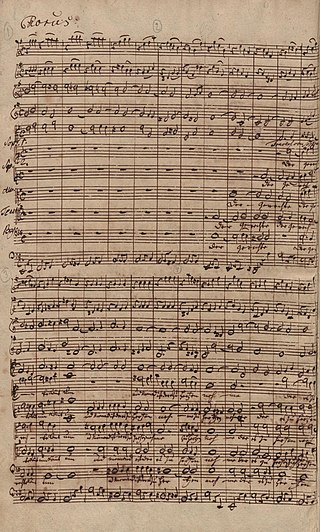
Wer ist der, so von Edom kömmt is a pasticcio Passion oratorio based on compositions by Carl Heinrich Graun, Georg Philipp Telemann, Johann Sebastian Bach and others. The pasticcio was assembled around 1750.
Robert White is an American tenor and voice teacher who has had an active performance career for eight decades. If he is not better known to the general public, it is because his career, confined to art song and the concert stage, has not brought him the wider renown of singers who make their careers in opera; but he has long been cherished by connoisseurs of vocal music for the pure lyric sweetness of his voice and his scrupulous musicianship.

Chorale is the name of several related musical forms originating in the music genre of the Lutheran chorale:
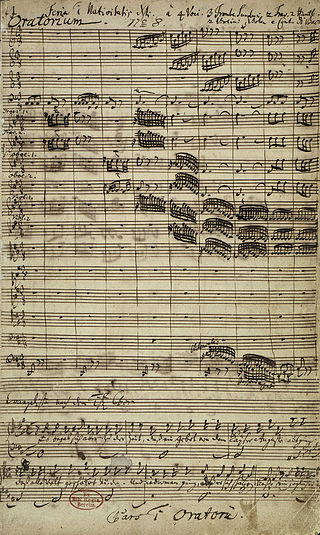
Jauchzet, frohlocket! Auf, preiset die Tage, BWV 248I, is a 1734 Christmas cantata by Johann Sebastian Bach that serves as the first part of his Christmas Oratorio. Bach was then Thomaskantor, responsible for church music at four churches in Leipzig, a position he had assumed in 1723. For the oratorio, the libretto by an unknown author followed the nativity of Jesus from the Gospel of Luke, interspersed with reflecting texts for recitatives and arias, and stanzas from Lutheran hymns.

Fallt mit Danken, fallt mit Loben, BWV 248IV, is a Christmas cantata by Johann Sebastian Bach, composed in 1734 as Part IV of his six-part Christmas Oratorio. Each part of the oratorio is a cantata, written for performance on one of the feast days of the Christmas period. Fallt mit Danken, fallt mit Loben is meant for the New Year's Day feast of the circumcision and naming of Jesus. Based on a libretto by an unknown author, it tells the naming of Jesus from the Nativity of Jesus, according to the Gospel of Luke.

Und es waren Hirten in derselben Gegend, BWV 248II, is a 1734 Christmas cantata by Johann Sebastian Bach as the second part of his Christmas Oratorio. Bach was then Thomaskantor, responsible for music at four churches in Leipzig, a position he had assumed in 1723.
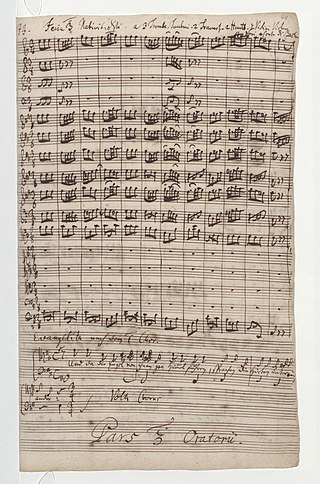
Herrscher des Himmels, erhöre das Lallen, BWV 248III, is a 1734 church cantata for the third day of Christmas (27 December) which Johann Sebastian Bach composed as the third part of his Christmas Oratorio. The Christmas cantata was first performed in 1734, in Leipzig. Bach was then Thomaskantor, responsible for music at four churches in Leipzig, a position he had assumed in 1723.
References
- 1 2 "A Commemorative Concert In Memory of Dr. Martin Luther King, Jr.". 1988-1989 Programs Presented by Guest Artists, Faculty, and Students (Program). University of Michigan. 1989. pp. 25–31 – via Google Books.
- 1 2 3 4 5 6 7 8 9 10 11 12 13 14 Walker-Hill, Helen (2007). From Spirituals to Symphonies: African-American Women Composers and Their Music. University of Illinois Press. pp. 73–76. ISBN 9780252074547.
- ↑ "Scenes from the Life of a Martyr". NPR. 20 January 2003. Retrieved 1 February 2016.
- 1 2 Kozinn, Allan (13 January 1989). "Art and Conscience Mix In King Observances". The New York Times. Retrieved 1 February 2016.
- ↑ Hudson, Herman (1986). "The Black Composer Speaks: An Interview with Undine Smith Moore" . Helicon Nine. 14/15: 172–185. Retrieved 1 February 2016– via EBSCO.
- ↑ Crutchfield, Will (19 January 1989). "The Voices In Honor of Dr. King". The New York Times. Retrieved 1 February 2016.
- ↑ Holland, Bernard (18 January 1982). "Collegiate Chorale Offers Premiere and Revival". The New York Times. Retrieved 1 February 2016.
- ↑ Rockwell, John (7 November 1985). "Five Works by Black Composer". The New York Times. Retrieved 1 February 2016.